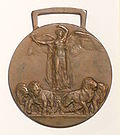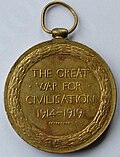| Country | Designer | Manufacturer | Number issued | Obverse | Reverse | Established by |
|---|
| Belgium | Paul Du Bois (1859–1938) | ----- | 300,000–350,000 |  |  | Royal Decree from 15 July 1919 |
| Brazil [ Wikidata ] | Jorge Soubre [ fr ] (1890–1934) | | approximately 2,500 |  |  | Decree nr. 16074 from 22 June 1923 |
| Cuba [ Wikidata ] | Charles Charles | | 6,000–7,000 |  |  | Decree nr. 905 from 10 June 1922 |
| Czechoslovakia [ cz ] | Otakar Španiel (1881–1955) | | approximately 89,500 |  |  | Decree from 27 July 1920 |
| France | Pierre-Alexandre Morlon [ fr ] (1878–1951) | | approximately 2,000,000 |  |  | Law from 20 July 1922 |
| Charles Charles [Note 1] | | ----- | | |
M. Pautot and Louis Octave Mattei [Note 1] | ----- | ----- | | |
| Greece | Henry-Eugène Nocq (1868–1944) | | approximately 200,000 |  |  | Law from 22 September 1920 |
| Italy | Gaetano Orsolini (1884–1954) | - Sacchini-Milano
- S.Johnson-Milano
- F.M.Lorioli & Castelli-Milano
| approximately 2,000,000 |  |  | Royal Decree nr. 1918 from 16 December 1920 |
| Japan [Note 2] | Shokichi Hata | | approximately 700,000 |  |  | Imperial Edict nr 406 from 17 September 1920 |
| Poland [Note 3] | .... Vlaitov | | ----- |  |  | |
| Portugal [ pt ] | João Da Silva (1880–1960) | | approximately 100,000 |  |  | Decree from 15 July 1919 |
| Romania | Constantin Kristescu (1871–1928) | | approximately 300,000 |  |  | Royal Decree nr 3390 from 20 July 1921 |
| Siam (Thailand) [ th ] | Itthithepsan Kritakara [ th ] (1890–1935) | ----- | approximately 1,500 |  |  | |
| South Africa [Note 4] | William McMillan (1887–1977) | | approximately 75,000 | |  | Decree from 1 September 1919 |
| United Kingdom [Note 5] | William McMillan (1887–1977) | | 6,334,522 plus |  |  | Decree from 1 September 1919 |
| United States | James Earle Fraser (1876–1953) | - Arts Metal Works Inc.
- S.G.Adams Stamp & Stationary Co.
- Jos. Mayer Inc.
| approximately 2,500,000 |  |  | General Order nr 48 from 9 April 1919 of the Department of War |
Source unless otherwise indicated: Alexander J. Laslo (1986). The Interallied Victory Medals of World War I. Albuquerque: Dorado Publishing. ISBN 0961732008.- Notes
- 1 2 Unofficial type.
- ↑ On the obverse the winged figure of Victory was replaced by Takemikazuchi, the war god in Japanese mythology.
- ↑ For reasons still not known, Poland did not proceed with the manufacture of the medal at their mint. The medal shows a clearly visible “MK” (Mint Kremnica). The medal may possibly be an unofficial strike by a veterans’ group.
- ↑ The text on the reverse is in English and Dutch.
- ↑ Awarded not only to British combatants but as well to those from the dominions of Canada, Australia, New Zealand and those from the Empire of India.
|

































